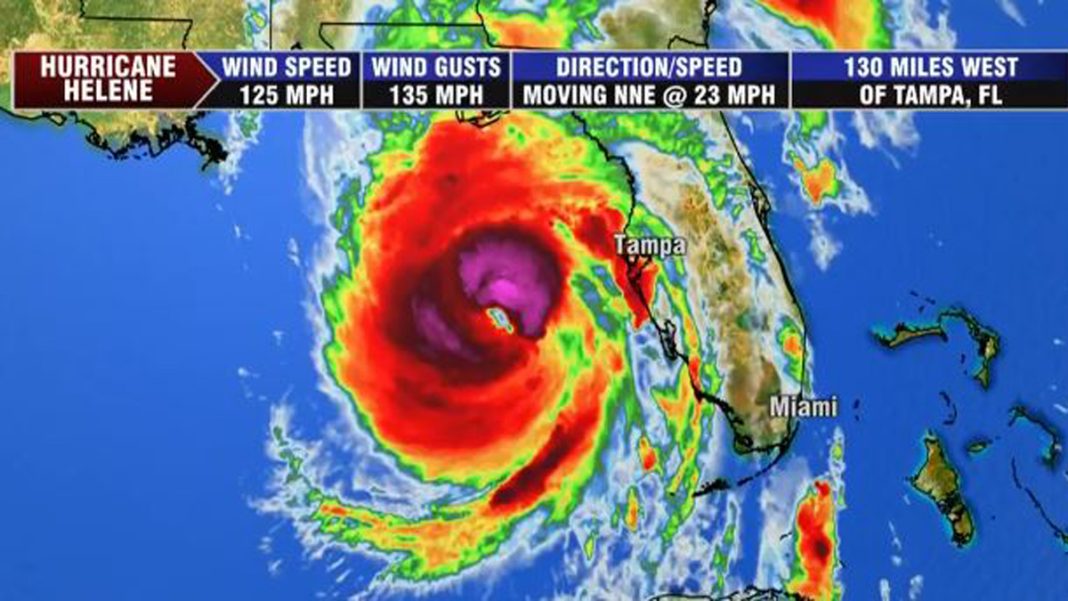As Hurricane Helene barreled toward the southeastern United States, it transformed from a ferocious Category 4 hurricane with maximum sustained winds of 140 mph to a tropical storm with winds of 70 mph by the time it reached Georgia. The National Hurricane Center reported the storm’s weakened state early Friday, but the damage and devastation it left in its wake were profound.
Making landfall near the mouth of the Aucilla River in Florida’s Big Bend area at around 11:10 p.m. Thursday, Helene’s approach was marked by intense warnings of a potentially catastrophic storm surge and hazardous winds. The storm’s trajectory was eerily familiar; it struck just 20 miles northwest of where Hurricane Idalia had devastated the region a year prior. Such patterns raise questions about the frequency and intensity of storms impacting this vulnerable coastline, particularly in the context of climate change.
As Helene advanced inland, it brought with it not only wind but also heavy rainfall, with forecasts predicting up to 14 inches of rain in parts of North Carolina. This deluge set the stage for potentially historic flooding, raising concerns among meteorologists and emergency management officials alike. “The flooding could be worse than anything seen in the past century,” warned forecasters, underscoring the urgency of preparedness in the affected areas.
Residents in Valdosta, Georgia—where the storm’s eye passed—sought refuge in hotels as the winds howled outside. Fermin Herrera, a local resident, recounted his family’s harrowing night, demonstrating the instinctive human response to seek safety in the face of nature’s fury. “We heard some rumbling,” he said, illustrating the moment of decision when anxiety turns into action. This sentiment was echoed by many, as Helene became the third storm to impact the city in just over a year, further solidifying the community’s resilience.
With over 1.2 million homes and businesses without power across Florida, Georgia, and the Carolinas, the impact of Helene was felt far beyond the immediate coastal regions. Emergency declarations issued by governors in affected states highlighted the seriousness of the situation. One tragic outcome of the storm was reported in Florida, where a sign fell on a vehicle, claiming a life. Meanwhile, in Georgia, two individuals lost their lives when a possible tornado struck a mobile home, accentuating the storm’s deadly potential.
As the storm progressed, officials issued hurricane and flash flood warnings well into Virginia, with predictions of tornado threats lingering across several states. The National Hurricane Center emphasized the need for people to remain sheltered, warning that conditions were life-threatening. This call to action is a stark reminder of the unpredictability and danger associated with hurricanes, even as they weaken.
Helene’s impact was felt even before landfall, with coastal areas experiencing tropical storm-force winds. Communities along Florida’s west coast saw water inundate roadways, while debris from recent storms washed ashore. The ongoing threat of storm surges, projected to reach as high as 20 feet in Apalachee Bay, was described by officials as “unsurvivable.”
The socio-economic ramifications of such storms cannot be overlooked. The Forgotten Coast of Florida, known for its natural beauty and sparse development compared to other beach areas, faces a unique challenge. Residents like Philip Tooke, a commercial fisherman, expressed the profound connection to their land and livelihoods, indicating the personal stakes involved in storm survival. “If I lose that, I don’t have anything,” he said, reflecting the dire realities faced by those who depend on the sea.
In the aftermath of Helene, as communities assess the damage and begin recovery, the broader implications of climate change loom large. The National Oceanic and Atmospheric Administration has warned of an above-average hurricane season this year, attributed to record-warm ocean temperatures. Experts like University of Georgia meteorology professor Marshall Shepherd suggest that Helene could represent one of the most significant storms to hit a major Southern city in 35 years, challenging our preparedness and response strategies.
As Helene moves further inland, its legacy extends beyond immediate destruction; it serves as a potent reminder of the increasing frequency and intensity of severe weather events. Communities must adapt not only through emergency response but also by reevaluating long-term resilience strategies in the face of a changing climate. With each storm, the lessons learned can shape the future, reinforcing the need for preparedness, community solidarity, and infrastructural resilience in an era marked by uncertainty.

